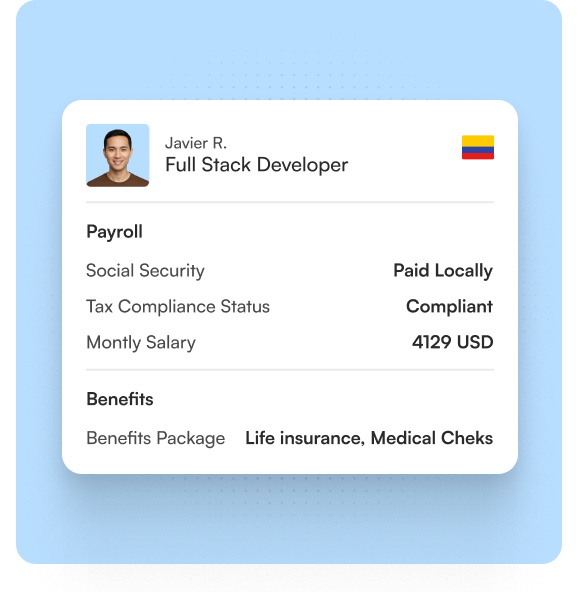The Difference Between Junior vs Senior Roles



Lupa will help you hire top talent in Latin America.
Book a Free Consultation
Lupa helps you build, manage, and pay your remote team. We deliver pre-vetted candidates within a week!
Book a Free ConsultationIn today's competitive professional landscape, understanding the distinction between junior vs senior roles is crucial for career planning and development. Whether you're a recent graduate, an early-career professional, or someone looking to advance to a senior position, knowing what separates these levels can help you set realistic expectations and develop the skills needed to progress.
These distinctions exist across virtually all industries and professions, from technology and marketing to finance and healthcare. The junior vs senior divide represents more than just years of experience—it encompasses differences in responsibility, autonomy, decision-making authority, compensation, and expected contributions to an organization.
Defining Junior and Senior Positions
Junior and senior represent different stages in a professional's career journey, with distinct expectations and responsibilities attached to each level.
Junior Positions
Junior roles typically represent entry-level positions for professionals with 0-2 years of experience in their field. These positions are designed for individuals who have foundational knowledge but limited practical experience. Junior professionals are expected to learn and develop under guidance, gradually taking on more responsibility as they gain experience.
Common junior job titles include Junior Developer, Junior Accountant, Junior Marketing Specialist, or Junior Designer. These roles focus on execution rather than strategy, with close supervision being a standard practice.
Senior Positions
Senior roles generally require 5+ years of relevant experience and demonstrate a high level of expertise and independence. Senior professionals are expected to have deep knowledge of their field, strong problem-solving abilities, and the capacity to lead and mentor others.
Typical senior job titles include Senior Software Engineer, Senior Financial Analyst, Senior Marketing Manager, or Senior Designer. These professionals are trusted with complex projects, strategic decision-making, and often have influence over departmental direction.
The Middle Ground: Mid-Level Positions
Between junior and senior levels exists what many organizations call "mid-level" or "medior" positions. These intermediate roles typically require 2-5 years of experience and represent a transition phase where professionals have gained significant experience but are still developing the expertise and leadership qualities needed for senior positions.
Mid-level professionals often work with less direct supervision than juniors but don't yet carry the strategic responsibilities of seniors. They may begin to mentor junior team members while still receiving guidance from senior colleagues.
It's worth noting that these definitions can vary slightly across industries and organizations. Some companies may have more granular distinctions, such as Associate, Junior, Intermediate, Senior, and Principal levels, while others might use a simpler junior-senior dichotomy.
Experience and Knowledge Requirements
The experience and knowledge expectations for junior vs senior professionals differ significantly, reflecting their respective stages in the career journey.
Junior Experience and Knowledge
Junior professionals typically have:
- Limited practical experience (0-2 years)
- Theoretical knowledge from education or training
- Basic understanding of industry tools and processes
- Familiarity with fundamental concepts in their field
- Eagerness to learn and develop professionally
For example, a junior developer might understand programming languages and basic algorithms but lack experience with large codebases or complex systems. Similarly, a junior marketer might know marketing principles but have limited experience executing campaigns independently.
Senior Experience and Knowledge
Senior professionals are characterized by:
- Extensive practical experience (5+ years)
- Deep industry and domain knowledge
- Mastery of tools, frameworks, and methodologies
- Understanding of business context beyond their specific role
- Ability to apply complex concepts to solve challenging problems
A senior software engineer, for instance, would have extensive experience with multiple programming languages, frameworks, and development methodologies. They would understand not just how to write code but how to architect systems, optimize performance, and ensure security and scalability.
Knowledge Breadth vs. Depth
Junior professionals typically have broad but shallow knowledge—they know a little about many aspects of their field. As they progress to mid-level and eventually senior positions, they develop both breadth and depth of knowledge.
Senior professionals are expected to have deep expertise in specific areas while maintaining sufficient breadth to understand how their work connects to other functions and the overall business objectives. This combination allows them to make informed decisions that consider both technical excellence and business impact.
Responsibility and Autonomy Differences
One of the most significant distinctions in the junior vs senior dynamic is the level of responsibility and autonomy granted to professionals at each level.
Junior Responsibilities and Autonomy
Junior professionals typically:
- Work under close supervision
- Handle simpler, well-defined tasks
- Follow established processes and procedures
- Seek approval before making significant decisions
- Focus on execution rather than strategy
- Learn from feedback and guidance
For example, a junior accountant might prepare basic financial reports following templates, with their work being reviewed by more senior team members. A junior designer might work on individual components of a project rather than leading the entire design process.
Senior Responsibilities and Autonomy
Senior professionals generally:
- Work independently with minimal supervision
- Manage complex projects and initiatives
- Develop and improve processes
- Make significant decisions autonomously
- Contribute to strategic planning
- Supervise and mentor others
A senior marketing manager might lead the development of an entire campaign strategy, manage the budget, coordinate across departments, and be accountable for results. Similarly, a senior software engineer might architect new systems, make critical technology decisions, and lead development teams.
Trust and Accountability
The difference in responsibility levels reflects the trust organizations place in professionals at different career stages. Junior professionals are given tasks where mistakes have limited consequences and can be easily corrected. As they prove their capabilities, they earn greater trust and are given more significant responsibilities.
Senior professionals are trusted with work that has substantial business impact. With this trust comes greater accountability—seniors are expected to deliver results, solve problems independently, and take ownership of their areas of responsibility.
Decision-Making Authority
The authority to make decisions is a key differentiator in the junior vs senior professional comparison, with significant implications for day-to-day work and career development.
Junior Decision-Making
Junior professionals typically have:
- Limited decision-making power
- Decisions confined to tactical, low-risk matters
- Requirement to seek approval for most decisions
- Focus on implementing decisions made by others
- Learning to evaluate options and make recommendations
A junior professional might decide how to approach a specific task but would need approval for anything that affects project timelines, budgets, or strategic direction. Their decision-making is often guided by established procedures and precedents.
Senior Decision-Making
Senior professionals generally have:
- Substantial decision-making authority
- Ability to make strategic and high-impact decisions
- Autonomy to determine approaches and solutions
- Input into organizational priorities and direction
- Responsibility for evaluating risks and trade-offs
A senior product manager, for instance, might decide on product features, prioritize development work, and make decisions that directly impact revenue and customer satisfaction. A senior financial analyst might make investment recommendations that influence company financial strategy.
Developing Decision-Making Skills
The progression from junior to senior involves developing increasingly sophisticated decision-making capabilities. Juniors learn to make good decisions by observing seniors, receiving feedback on their recommendations, and gradually taking on more decision-making responsibility.
As professionals advance to mid-level and senior positions, they're expected to make decisions that consider broader business context, long-term implications, and complex trade-offs. This requires developing judgment based on experience, understanding organizational priorities, and balancing competing factors.
Salary and Compensation Differences
Compensation differences between junior vs senior positions reflect the increased value, responsibility, and scarcity of experienced professionals.
Junior Compensation
Junior professionals typically receive:
- Entry-level salaries appropriate to their industry and location
- Limited or no bonuses
- Standard benefits packages
- Few if any equity or profit-sharing opportunities
- Compensation focused primarily on base salary
For example, a junior software developer in the United States might earn between $60,000 and $90,000 annually, depending on location and company size. A junior marketing specialist might earn $40,000 to $60,000.
Senior Compensation
Senior professionals generally command:
- Significantly higher base salaries (often 50-100% more than juniors)
- Performance-based bonuses
- Enhanced benefits packages
- Potential equity or profit-sharing arrangements
- More comprehensive total compensation packages
A senior software engineer at a technology company might earn $120,000 to $200,000+ in base salary, plus bonuses and equity that could add 20-50% to their total compensation. A senior marketing manager might earn $90,000 to $150,000+ with additional performance incentives.
Factors Influencing Compensation
Beyond just the junior vs senior designation, several factors influence compensation:
- Location: Salaries vary significantly by geographic region, with major tech hubs and financial centers typically offering higher compensation.
- Industry: Some industries (like technology, finance, and healthcare) generally offer higher compensation than others.
- Company size and type: Larger companies and well-funded startups often pay more than small businesses or non-profits.
- Specialized skills: In-demand skills can command premium compensation, particularly at the senior level.
- Individual negotiation: Especially at senior levels, negotiation skills can significantly impact total compensation.
Compensation Growth
The salary gap between junior and senior roles highlights the financial incentive for career advancement. While junior salaries tend to cluster in a relatively narrow range, senior compensation can vary widely based on performance, specialized expertise, and leadership capabilities.
This compensation growth isn't linear—professionals often see modest increases during their junior years, with more substantial jumps as they reach mid-level and senior positions. This reflects the exponentially increasing value that comes with experience, judgment, and leadership abilities.
Skill Development and Expectations
The skills expected of professionals evolve significantly as they progress from junior to senior levels, with different emphasis placed on technical vs. soft skills.
Junior Skill Expectations
Junior professionals are typically expected to have:
- Solid foundational technical skills in their field
- Basic understanding of industry tools and processes
- Strong learning ability and adaptability
- Good communication skills
- Willingness to receive feedback and guidance
For a junior developer, the focus might be on coding proficiency, understanding of basic algorithms, and ability to implement features according to specifications. A junior accountant would need to understand accounting principles, financial software, and basic reporting procedures.
Senior Skill Expectations
Senior professionals are expected to demonstrate:
- Advanced technical expertise in their domain
- Leadership and mentorship capabilities
- Strategic thinking and business acumen
- Project and people management skills
- Problem-solving at a systems level
- Effective communication with diverse stakeholders
A senior marketing professional would need not only marketing expertise but also leadership skills, strategic vision, budget management abilities, and cross-functional collaboration capabilities. A senior engineer would need advanced technical skills plus the ability to architect systems, lead teams, and align technical decisions with business goals.
The Shifting Balance of Hard and Soft Skills
As professionals progress from junior to senior levels, the relative importance of different skills shifts:
- Junior level: Heavy emphasis on technical/hard skills (70-80%) with some soft skills (20-30%)
- Mid-level: More balanced mix of technical (50-60%) and soft skills (40-50%)
- Senior level: Continued technical expertise (40-50%) but increased emphasis on soft skills (50-60%)
This doesn't mean technical skills become less important—senior professionals still need strong technical foundations. However, their value increasingly comes from their ability to lead, communicate, strategize, and solve complex problems that require both technical and business understanding.
Continuous Skill Development
The journey from junior to senior involves continuous skill development across multiple dimensions. Junior professionals focus primarily on building technical proficiency and learning industry practices. As they advance to mid-level and senior positions, they need to develop leadership, strategic thinking, and business acumen while continuing to evolve their technical expertise.
This skill development happens through a combination of formal training, mentorship, challenging assignments, and deliberate practice. Organizations that support this development through learning and development trends and opportunities often see faster progression of junior talent to senior levels.
{{staffing-embed}}
Mentorship and Leadership Responsibilities
The relationship to mentorship and leadership represents another significant difference in the junior vs senior professional dynamic.
Junior Professionals as Mentees
Junior professionals typically:
- Receive mentorship and guidance from more experienced colleagues
- Focus on their own development and learning
- Have limited or no leadership responsibilities
- Observe leadership practices to develop their own style
- Contribute primarily as individual contributors
For junior professionals, being an effective mentee means being receptive to feedback, proactively seeking guidance, and applying lessons learned to improve their work. Their relationship with leadership is primarily as recipients of direction and development.
Senior Professionals as Mentors and Leaders
Senior professionals generally:
- Provide mentorship to junior and mid-level colleagues
- Take responsibility for developing team capabilities
- Lead projects, initiatives, or entire teams
- Influence organizational culture and practices
- Balance individual contribution with leadership responsibilities
A senior professional might formally mentor several junior team members, providing career guidance, technical advice, and performance feedback. They often serve as project leads or team managers, taking responsibility for both deliverables and team development.
Leadership Without Management
It's important to note that leadership responsibilities at the senior level don't necessarily mean formal management positions. Many senior professionals exercise "technical leadership" or "thought leadership" without directly managing others.
For example, a senior software engineer might lead architecture decisions, establish coding standards, and guide technical direction without having direct reports. A senior financial analyst might lead the development of financial models and investment strategies that guide company decisions.
Creating a Mentorship Culture
Organizations that excel at developing talent often create structured mentorship programs that pair junior professionals with senior mentors. These relationships accelerate junior development while giving seniors valuable leadership experience.
The best mentorship relationships benefit both parties—juniors gain knowledge and guidance, while seniors gain fresh perspectives and develop their leadership capabilities. This reciprocal learning is a hallmark of healthy organizational cultures and effective professional development.
Career Progression: Moving from Junior to Senior
Understanding the path from junior to senior positions helps professionals plan their career development and set realistic expectations for advancement.
Typical Career Progression Timeline
While timelines vary by industry and individual, a typical progression might look like:
- Junior level: 0-2 years of experience
- Mid-level: 2-5 years of experience
- Senior level: 5+ years of experience
- Principal/Lead/Director: 8-15+ years of experience
This progression isn't purely time-based—advancement depends on developing the skills, knowledge, and capabilities required at each level. Some professionals advance more quickly by rapidly acquiring relevant skills and demonstrating exceptional performance.
Key Milestones for Advancement
The journey from junior to senior typically involves several key milestones:
- Technical proficiency: Mastering the core technical skills of your profession
- Autonomy: Demonstrating ability to work independently with minimal supervision
- Problem-solving: Showing capacity to solve complex, ambiguous problems
- Leadership: Taking on leadership responsibilities, formally or informally
- Strategic thinking: Developing ability to connect work to broader business goals
- Mentorship: Successfully guiding and developing others
These milestones aren't sequential—professionals typically develop across multiple dimensions simultaneously, with different emphasis at different career stages.
Strategies for Accelerating Progression
Professionals looking to advance from junior to senior positions can employ several strategies:
- Seek challenging assignments that stretch your capabilities and provide growth opportunities
- Find mentors who can provide guidance, feedback, and advocacy
- Develop T-shaped skills with depth in your core area and breadth across related domains
- Build your network both within and outside your organization
- Take initiative by identifying problems and proposing solutions
- Request feedback regularly and act on it to improve performance
- Develop soft skills alongside technical expertise
- Demonstrate leadership even without formal authority
Organizations can support this progression through structured development programs, clear career paths, regular feedback, and mentorship opportunities.
Recognizing Readiness for Advancement
Professionals should regularly assess their readiness for advancement by considering:
- How their skills and contributions compare to those at the next level
- Feedback from managers and senior colleagues
- Their comfort level with responsibilities typical of the next level
- The gap between their current capabilities and those required for advancement
This self-assessment, combined with formal performance reviews, helps identify specific development needs and determine when to pursue promotion opportunities.
Industry-Specific Differences
While the junior vs senior distinction exists across virtually all industries, the specific expectations and career paths can vary significantly by field.
Technology Industry
In technology, the junior vs senior divide is particularly well-defined:
Junior Software Engineers (0-2 years):
- Focus on coding and implementing features
- Work on well-defined tasks with clear requirements
- Receive code reviews and technical guidance
- Learn development processes and tools
- Typically work on one component or feature at a time
Senior Software Engineers (5+ years):
- Design and architect systems and complex tasks
- Make technology selection decisions
- Review others' code and provide technical mentorship
- Consider performance, security, and scalability
- Balance technical excellence with business needs
- Often lead development teams or initiatives
The progression often includes intermediate roles like "Software Engineer II" or "Mid-level Developer." Technology also has extended career paths beyond senior developers, including Staff Engineer, Principal Engineer, Programmers, and Technical Fellow roles that represent increasing technical leadership without necessarily moving into management.
Marketing and Communications
In marketing, the progression looks somewhat different:
Junior Marketing Specialists (0-2 years):
- Execute specific marketing tactics
- Create content following established guidelines
- Assist with campaign implementation
- Analyze basic marketing metrics
- Support senior team members on larger initiatives
Senior Marketing Managers (5+ years):
- Develop comprehensive marketing strategies
- Manage substantial marketing budgets
- Lead cross-functional marketing initiatives
- Analyze complex market data and know how to inform decisions
- Mentor junior marketers and build team capabilities
Marketing careers often branch into specialized tracks (content, social media, digital, brand, product marketing) or general management paths. The highest paying marketing jobs typically combine strategic leadership with specialized expertise.
Finance and Accounting
Finance demonstrates yet another pattern:
Junior Financial Analysts (0-2 years):
- Prepare financial reports and analyses
- Maintain financial models and databases
- Support budgeting and forecasting processes
- Conduct basic financial research
- Learn industry regulations and standards
Senior Financial Managers (5+ years):
- Develop financial strategies and policies
- Lead complex financial analyses and modeling
- Make investment and resource allocation recommendations
- Manage relationships with external financial partners
- Guide financial decision-making across the organization
Finance careers often include professional certifications (CPA, CFA, etc.) that mark important milestones in the junior-to-senior progression. The field also has clear distinctions between technical financial roles and financial management positions.
Cross-Industry Patterns
Despite these differences, some patterns in the junior vs senior distinction apply across industries:
- Increasing scope: Progression from narrow, specific responsibilities to broader, more strategic ones
- Growing autonomy: Less supervision and more independent decision-making
- Expanding impact: From affecting individual projects to influencing entire organizations
- Developing leadership: From individual contribution to guiding and developing others
These common patterns make it possible for professionals to transfer skills and level of experience across industries, particularly at senior levels where leadership and strategic capabilities become increasingly important.
Ready to Build Your Dream Team with Top LatAm Talent?
Understanding the junior vs senior dynamic is crucial when building effective teams. At Lupa, we specialize in connecting US companies with premium Latin American talent across all experience levels. Our deep understanding of role requirements and cultural alignment ensures you find the perfect match—whether you need junior developers with fresh perspectives or senior leaders who can drive your projects forward.
Ready to elevate your team with exceptional talent? Connect with Lupa today and discover how our premium matching service can transform your hiring process.























